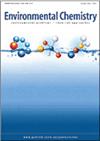Validation of a calibration model able to estimate the concentration of pesticides in an alpine stream through passive sampling (POCIS) monitoring
IF 2.3
4区 环境科学与生态学
Q3 CHEMISTRY, ANALYTICAL
引用次数: 0
Abstract
Environmental context Pesticides and other contaminants released by agricultural activities negatively impact aquatic biota and water quality, but are not always measured. The Polar Organic Chemical Integrative Sampler (POCIS) is among the most suitable tools for identifying pesticides and other organic compounds in water bodies. However, determination of a mean concentration (over the duration of the deployment) is still a significant challenge, which is addressed in the present work using field observations and a computational model.Rationale The Polar Organic Chemical Integrative Sampler (POCIS) is a passive sampler composed of a receiving phase, Oasis HLB, enclosed between two polyethersulfone (PES) membranes. It is used for monitoring organic compounds in surface water and in groundwater. The measurement of pesticide concentrations by passive samplers in streams still represents an open challenge, which limits the samplers’ use in environmental monitoring of the quality status of water bodies in accordance with the EU Water Framework Directive.Methodology We addressed these limitations by calibrating a POCIS with concentration measurements performed on samples collected by means of an automatic sampler from the same section of a small alpine river where a passive sampler was deployed. In the majority of published studies, the analytes were extracted only from the receiving phase, but recent works show that some compounds were also adsorbed by the PES membrane, suggesting the importance of extracting the analytes from both the phase and the membrane.Results The POCIS was calibrated for 31 compounds, by a comparison between the total amount of pesticides adsorbed by POCIS (Ms) and the time-weighted average concentration (TWAc) obtained from several grab samples, and by estimation of the sampling rate (Rs), which allows linking the Ms with the TWAc over time. The data showed an increasing Rs trend with hydrophobicity for the most hydrophobic and hydrophilic compounds, while compounds with 1.5 ≤ log Kow ≤ 3.5 assumed a value of Rs independent of log Kow. The contribution of PES membranes allows expansion of the calibration of Rs to the most hydrophobic compounds and allows monitoring of pesticides that would hardly have been detected if they were extracted only from the Oasis HLB phase, such as fluazinam.Discussion The calibration was then verified on the same stream and the model extended to a different sampling site; in both cases, the calibration allowed estimation of a value of TWAc that fits with the reality within a factor of 5, and in the majority of cases within a factor of 2. If this level of accuracy is accepted, the Rs reported here can be used to estimate TWAc from sampling with POCIS.通过被动采样(POCIS)监测估算高山溪流中农药浓度的校准模型的验证
农业活动释放的农药和其他污染物对水生生物群和水质产生负面影响,但并不总是进行测量。极性有机化学综合采样器(POCIS)是鉴定水体中农药和其他有机化合物最合适的工具之一。然而,确定平均浓度(在部署期间)仍然是一个重大挑战,目前的工作是利用实地观测和计算模型来解决这个问题。极性有机化学集成进样器(POCIS)是一种被动进样器,由接收相Oasis HLB组成,封装在两层聚醚砜(PES)膜之间。它用于监测地表水和地下水中的有机化合物。通过被动采样器测量溪流中的农药浓度仍然是一个公开的挑战,这限制了采样器在根据欧盟水框架指令对水体质量状况进行环境监测中的使用。我们解决了这些局限性,通过校准POCIS,对使用自动采样器采集的样品进行浓度测量,这些样品来自一条小型高山河流的同一段,其中部署了被动采样器。在大多数已发表的研究中,分析物仅从接收相中提取,但最近的研究表明,一些化合物也被PES膜吸附,这表明从相和膜中提取分析物的重要性。结果通过比较POCIS吸附的农药总量(Ms)与多个抓取样品的时间加权平均浓度(TWAc),并通过估计采样率(Rs),将Ms与TWAc随时间的变化联系起来,对31种化合物的POCIS进行了校准。数据显示,大多数疏水和亲水化合物的Rs值随疏水性的增加而增加,而1.5≤log Kow≤3.5的化合物的Rs值与log Kow无关。PES膜的贡献允许将Rs的校准扩展到大多数疏水性化合物,并允许监测如果仅从Oasis HLB相中提取几乎无法检测到的农药,例如氟西南。然后在同一流上验证了校准,并将模型扩展到不同的采样点;在这两种情况下,校准允许估计TWAc的值,该值在5因子内与实际相符,在大多数情况下在2因子内。如果这个精度水平被接受,这里报告的Rs可以用来估计POCIS抽样的TWAc。
本文章由计算机程序翻译,如有差异,请以英文原文为准。
求助全文
约1分钟内获得全文
求助全文
来源期刊

Environmental Chemistry
环境科学-分析化学
CiteScore
4.50
自引率
0.00%
发文量
0
审稿时长
2.7 months
期刊介绍:
Environmental Chemistry publishes manuscripts addressing the chemistry of the environment (air, water, earth, and biota), including the behaviour and impacts of contaminants and other anthropogenic disturbances. The scope encompasses atmospheric chemistry, geochemistry and biogeochemistry, climate change, marine and freshwater chemistry, polar chemistry, fire chemistry, soil and sediment chemistry, and chemical aspects of ecotoxicology. Papers that take an interdisciplinary approach, while advancing our understanding of the linkages between chemistry and physical or biological processes, are particularly encouraged.
While focusing on the publication of important original research and timely reviews, the journal also publishes essays and opinion pieces on issues of importance to environmental scientists, such as policy and funding.
Papers should be written in a style that is accessible to those outside the field, as the readership will include - in addition to chemists - biologists, toxicologists, soil scientists, and workers from government and industrial institutions. All manuscripts are rigorously peer-reviewed and professionally copy-edited.
Environmental Chemistry is published with the endorsement of the Commonwealth Scientific and Industrial Research Organisation (CSIRO) and the Australian Academy of Science.
 求助内容:
求助内容: 应助结果提醒方式:
应助结果提醒方式:


